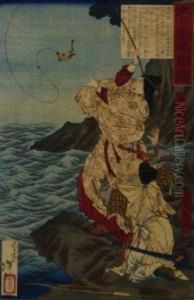Utagawa Yoshitoshi Paintings
Utagawa Yoshitoshi, also known as Taiso Yoshitoshi, was a Japanese artist who is widely recognized as the last great master of the ukiyo-e genre of woodblock printing and painting. Yoshitoshi was born in Edo (present-day Tokyo), Japan, on April 30, 1839, and he lived through a period of profound political, social, and cultural change in Japan, witnessing the end of the Edo period and the dawn of the Meiji Restoration.
As a young boy, Yoshitoshi showed an early interest in art, and at the age of eleven, he began his apprenticeship with Utagawa Kuniyoshi, one of the prominent ukiyo-e masters of the time. Kuniyoshi's influence on Yoshitoshi was significant, not only in the development of his skills but also in his interest in subjects from Japanese history and folklore, as well as the supernatural.
Yoshitoshi's career spanned a time of transition in Japan as the country opened up to the West after more than two centuries of relative isolation. His works reflect both a commitment to the traditions of ukiyo-e and an innovative approach that incorporated elements from Western art, such as perspective and shading. Yoshitoshi was known for his imaginative and often dramatic designs, which ranged from beautiful courtesans and Kabuki actors to bloody scenes of warriors and tales of ghosts and demons. His series 'One Hundred Aspects of the Moon' from the 1880s is particularly famous for its poetic and atmospheric depictions of various characters, both historical and mythical, under the moonlight.
Despite his artistic brilliance, Yoshitoshi struggled with poverty and mental illness throughout his life, and these personal hardships influenced the darker and more melancholic themes in his later works. He continued to produce impressive pieces until his death from a cerebral hemorrhage on June 9, 1892. Today, Yoshitoshi is celebrated for his technical prowess, his vivid imagination, and his ability to capture the essence of human emotions. His legacy endures as a bridge between the traditional Japanese aesthetics of the Edo period and the modernizing influences of the Meiji era.
